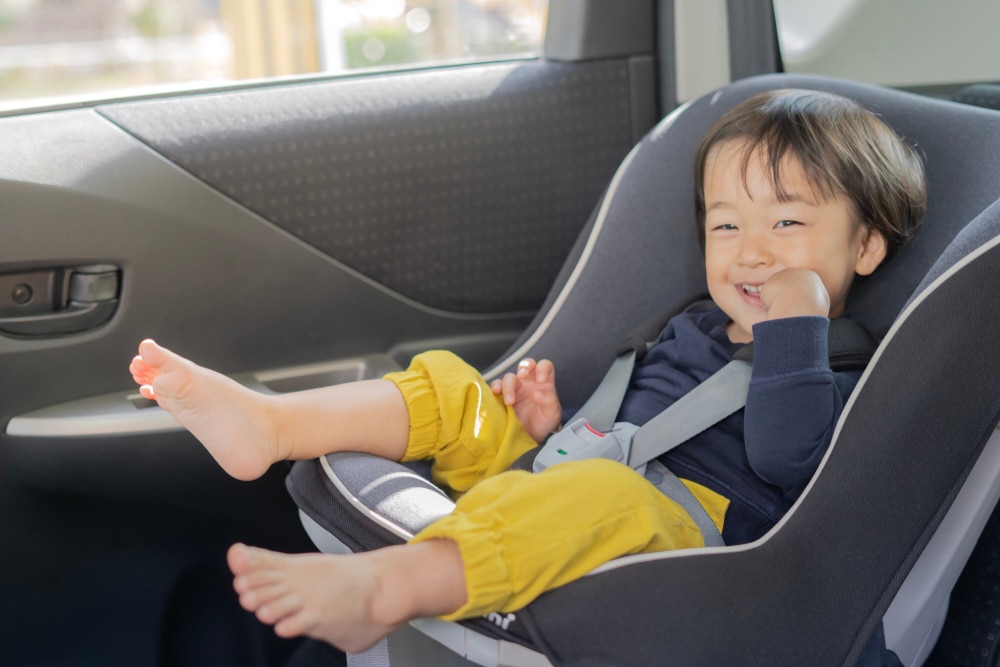Iowa car seat laws differ slightly from those in many other states, although the law’s intent is fundamentally similar. Here’s what you should know about the Iowa belt seat law, including who it applies to and who it doesn’t.
Legal Disclaimer: This guide is not legal advice and should not be treated as such. The law may have changed since the last time we updated this guide. If you are involved in a legal matter involving Iowa car seat laws, speak to a licensed attorney or a similarly qualified individual. Only a professional can give you legal advice.
What Is A Child Restraint System?

Under Iowa law, a child restraint system is any specially-designed seating system that meets federal safety standards.
Iowa Car Seat Law: Basic Information
The main focus of Iowa car seat laws is Iowa Code 321.446, which consists of seven primary sections and assorted supplementary information. It is not an incredibly long segment of the law, but it does clarify details about child restraint devices and when you should use them.
Unlike some other states, Iowa applies its laws to three main categories of children, rather than two.
Safety Law For Newborns
Under Iowa state law, newborns (which, in this case, refers to children who are both under one year old and who weigh less than twenty pounds) must sit in a rear-facing child restraint system. This doesn’t apply to school buses or motorcycles but generally applies to other vehicles subject to registration.
Incidentally, this law does not place a limit on the location of registration. For example, it applies even if you’re registered out-of-state, though the law itself only applies within Iowa’s borders. Most people don’t need to worry about this detail, but we’re bringing it up to illustrate how important it is to understand laws’ specific wording.
Safety Law For Young Children
In this context, young children refers to children who are under six years of age, but who do not meet the definition of newborns given above. For children in this category, the booster seat laws Iowa enforces are similar to those for newborns except that the child restraint systems no longer need to be rear-facing.
Safety Law For Older Children
Older children, which includes children between the ages of six and eighteen, must also sit within a child restraint system.
Alternatively, older children can use a safety belt or a safety harness as described in Section 321.445 of Iowa state law. The changeover usually occurs when a child is too tall or heavy to fit within a traditional child restraint system. While that varies by child and vehicle, it’s usually well before their teens.
Exceptions
Like most states, Iowa car seat laws have several exceptions that define when the laws do not apply. Most parents never move into this category, but it’s important to know what they are in case they end up applying to you. Here are the main categories for exceptions.
Peace Officers
Specifically, the law does not apply to peace officers while they are acting on official duties. In Iowa, the term “peace officer” is relatively broad and refers to multiple law enforcement roles like deputy sheriffs, police officers, and state patrol officers.
Essentially, this exclusion means that peace officers can transport children as needed, without worrying about restraint systems. For example, if a state trooper finds a young child lost along the road, they can pick up the child and bring them to an appropriate facility.
Vehicle Types
Iowa car seat laws for restraint systems don’t apply to a broad section of vehicles, either. These include vehicles from 1965 or older model years, buses, motor homes, recreational vehicles, or buses.
The bus exception is mainly for schools because school buses are extraordinarily safe. That said, several states require seatbelts on school buses, and Iowa may choose to join them at some point.
Finally, while motorhomes and recreational vehicles are mostly exempt, the exemption does not apply if children are in passenger seats immediately to the right of the driver. These seats are usually compatible with child restraint systems, so parents should use them as possible.
Medical Limitations
Restraint laws in Iowa do not apply to children, regardless of age, if a physician certifies that the child has any medical, mental, or physical condition that makes it inadvisable to use a car seat.
This is what some people refer to as a “common sense” exemption in the law, similar to the way peace officers don’t have to follow these particular regulations. In general, state laws tend to assume that people in certain professions have more information than the average person and that it is better to defer to their opinions in certain circumstances.
For example, what this section really means is “don’t use a restraint system if a physician thinks it would hurt the child”. A child might be hurt if they’re in a collision but not in a restraint system, but if the system itself can hurt them, the chance of being injured in a crash is far less likely than being hurt by the device that’s supposed to protect them.
Lack Of Space
Finally, Iowa state law does not apply to anyone sitting in a rear seat where no safety belts are available because they’re being used by other passengers or child restraint systems. While parents should not drive a vehicle with more passengers than intended, some restraint systems may make it difficult to fit everyone in the car or use certain safety systems.
If this applies to you, consider looking for other ways to improve passenger safety. For example, some custom foam pads could provide extra cushioning or help stop people from shifting around. This isn’t as ideal as using seatbelts or child restraint systems, but it might be better than nothing.
The Exemption That Doesn’t Exist: Emergency Transportation
Section 321.446 of Iowa state law does not provide a general exemption for parents’ emergency transportation (although there is an exemption for authorized emergency vehicles).
This is different from some other states, which allow emergency transportation in any vehicle, under the theory that a child’s health needs outweigh the importance of using a proper restraint system.
In practice, what this means is that if your child is experiencing an emergency and you cannot put them in a restraint system, only an authorized emergency vehicle can lawfully transport them under Section 321.446.
See Related States: Minnesota Laws | California Laws | Ohio Laws
Can I Actually Get Punished For This?
Theoretically, yes. The law is the law, and violations of this part of Iowa law are typically simple misdemeanors. However, in practice, most police officers and courts are willing to grant exemptions for emergency transportation and aren’t likely to charge or punish you for attempting to get medical help for an injured child.
This is not encouragement to break the law. If the situation permits, you should get an emergency vehicle to transport any child who is experiencing an emergency and who, for whatever reason, cannot use a traditional restraint system.
However, if the situation is so urgent that calling an authorized emergency vehicle would take too long, you should do what’s necessary to protect the child. Notably, failure to use a child restraint system is not negligence, and it is not admissible as evidence (not for civil actions, anyway) under Iowa state law.






